Key takeaways:
- Feedback serves as a critical tool for artistic growth, helping creators refine their skills and rethink their work through others’ perspectives.
- Direct interactions with fans and collaborations with fellow artists provide valuable insights that can lead to deeper emotional connections in music.
- Engaging with data from streaming and social media analytics can shape creative decisions and inform a label’s strategy.
- Establishing a culture of open feedback fosters a supportive environment that encourages innovation and continuous improvement in music creation.
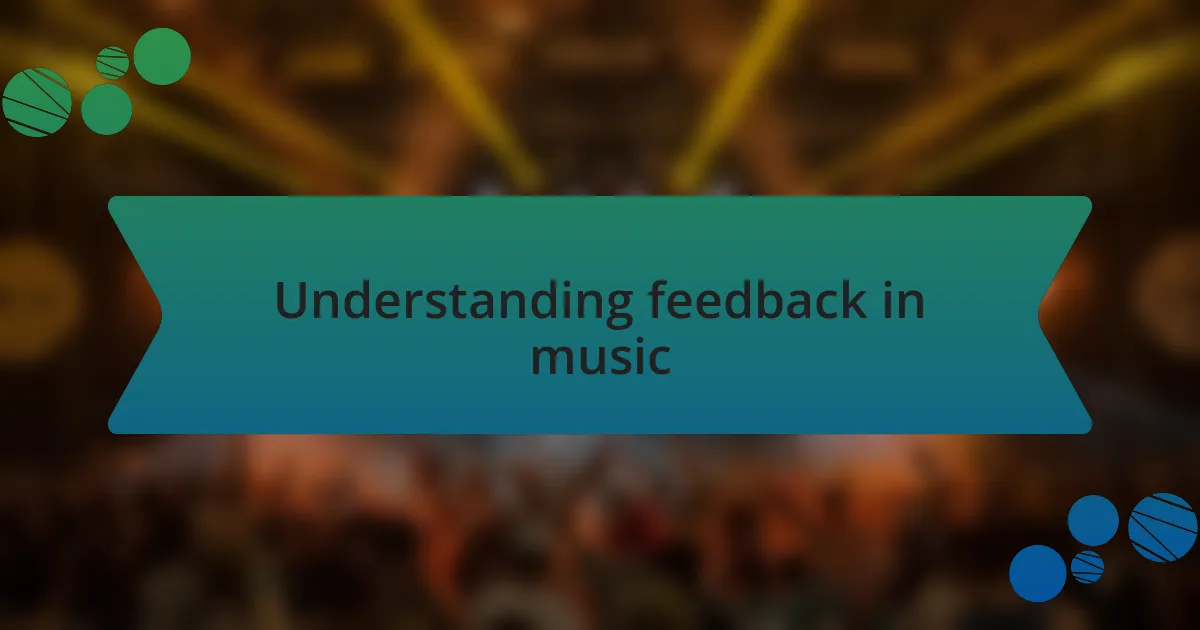
Understanding feedback in music
Feedback in music can often feel like a double-edged sword. On one hand, it’s exhilarating to hear someone genuinely connect with your work, while on the other, constructive criticism can sometimes sting. I remember sharing an early demo of mine with a close friend who, instead of praising it, pointed out the flaws in the mix. At first, I felt defensive, but that moment pushed me to refine my skills in ways I hadn’t considered before.
When we think about feedback, it’s essential to dissect not just what is said, but how it resonates. One comment I received about my sound design was particularly impactful; a listener described it as “hypnotic yet chaotic.” That description stuck with me, leading me to explore the balance between structure and spontaneity in my compositions. Have you ever had a piece of feedback change your artistic direction? It’s moments like those that can truly redefine your approach.
Ultimately, feedback serves as a mirror reflecting our artistic identity. It invites us to step outside of ourselves and observe our work through the eyes of others. In my experience, debating the comments I receive with fellow artists has led to profound revelations about my sound and style. Isn’t it fascinating how a few words can carve new paths in our creative journeys? Engaging with feedback isn’t just about receiving it; it’s about evolving with it.
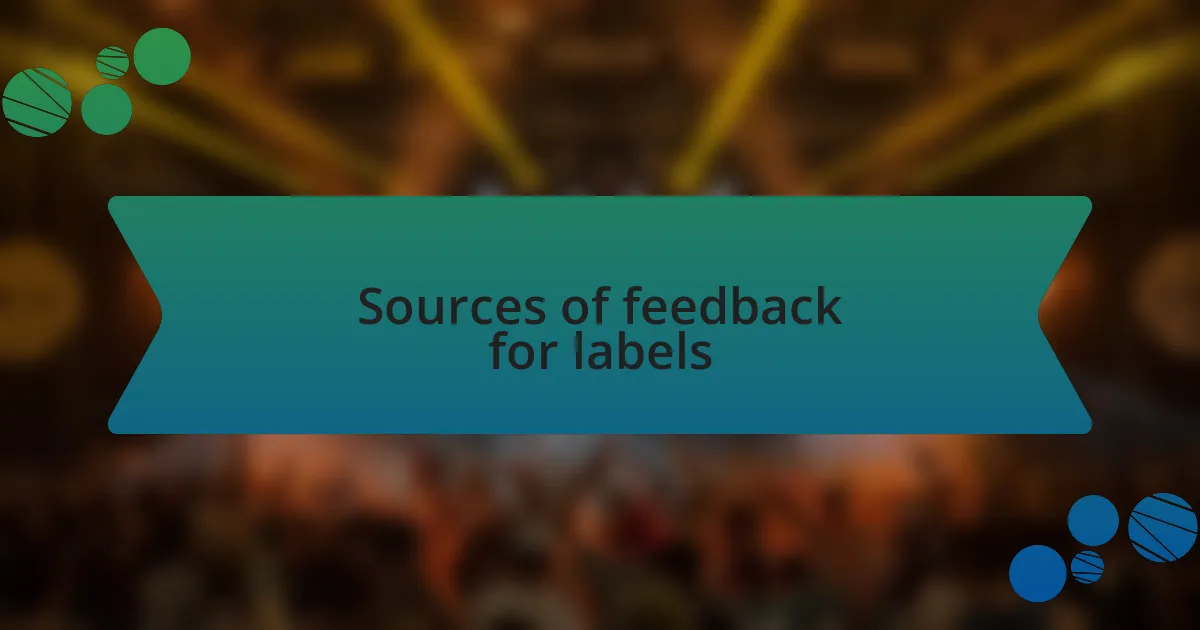
Sources of feedback for labels
When I think about the sources of feedback for labels, one of the most valuable is direct interaction with fans. I remember hosting a listening party for one of my tracks, and seeing the audience’s reactions in real-time was enlightening. Their genuine laughter or puzzled expressions provided insights that no survey could match. Have you ever witnessed how the energy in the room shifts with each drop? That palpable energy can guide a label’s direction, steering it toward what resonates most profoundly with listeners.
Another crucial source is collaboration with other artists. I’ve found that sharing my work-in-progress with fellow musicians often yields surprising insights. Just last month, a producer friend pointed out a unexpected timing issue in one of my tracks that I had missed entirely. This interaction made me realize that sometimes, a fresh pair of ears can unlock hidden potential. How often do you reach out to your peers for that critical edge? Welcoming their perspectives can lead to elevating a project beyond what I initially envisioned.
It’s not just about human feedback, though. The analytics from streaming platforms and social media provide a wealth of data. I once dove deep into the metrics of my most successful track and discovered patterns that revealed listener preferences I hadn’t anticipated. Analyzing which parts of the track were replayed or skipped off gave me a clearer picture of what my audience craved. How do you think data can influence creative decisions? Embracing these insights can dramatically shape a label’s strategy in today’s fast-paced electronic music landscape.
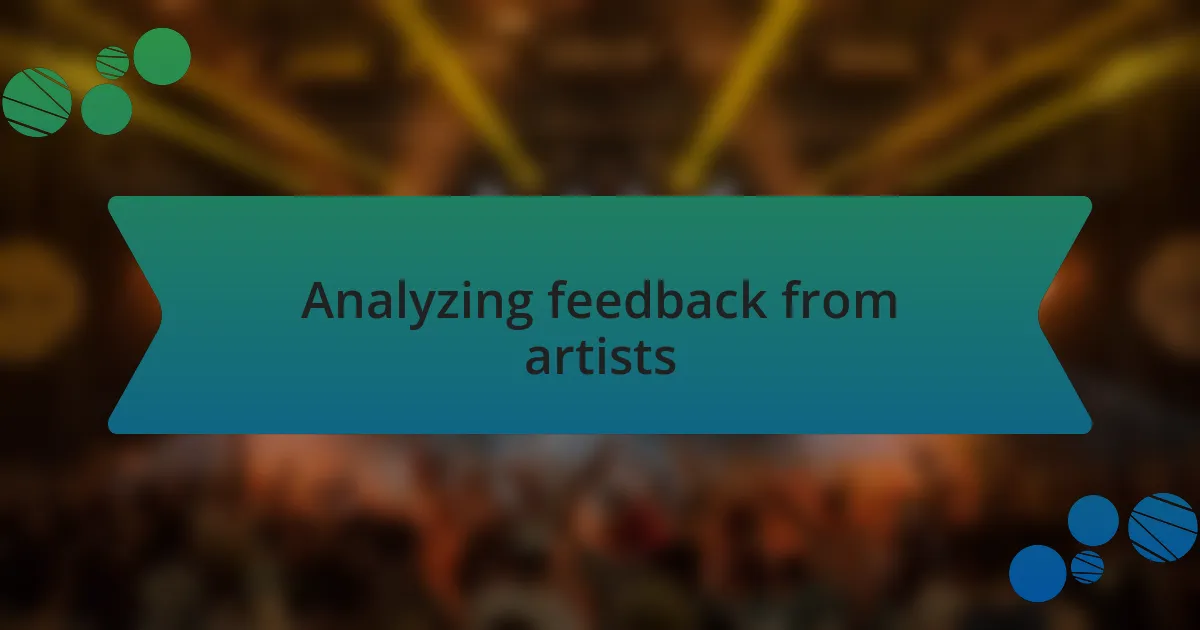
Analyzing feedback from artists
When analyzing feedback from artists, I often find their perspectives incredibly nuanced. For instance, after releasing a collaborative track, I was surprised by a fellow artist’s comment on the song structure. They suggested altering the breakdown to enhance emotional impact, which made me reconsider how I structure my tracks. Have you ever had a moment where an artist’s insight flipped a creative project on its head?
Listening to artists’ concerns also helps me gauge the emotional weight of a track. I once received feedback from a vocalist who felt that her lyrics were overshadowed by the production elements. This observation made me rethink my mixing approach, ensuring I balanced the instrumental and vocal elements effectively. Don’t you think that sometimes, stripping back layers can reveal the raw emotion that resonates most with listeners?
Additionally, creating a supportive environment for feedback can lead to deeper revelations. During a recent project, I set up an informal feedback session where artists could express their thoughts freely. The candidness of that discussion opened my eyes to shared vulnerabilities and creative struggles we often face. How often do you encourage open dialogue with your collaborators? This honest exchange not only strengthens our music but also builds a community where we can all thrive.
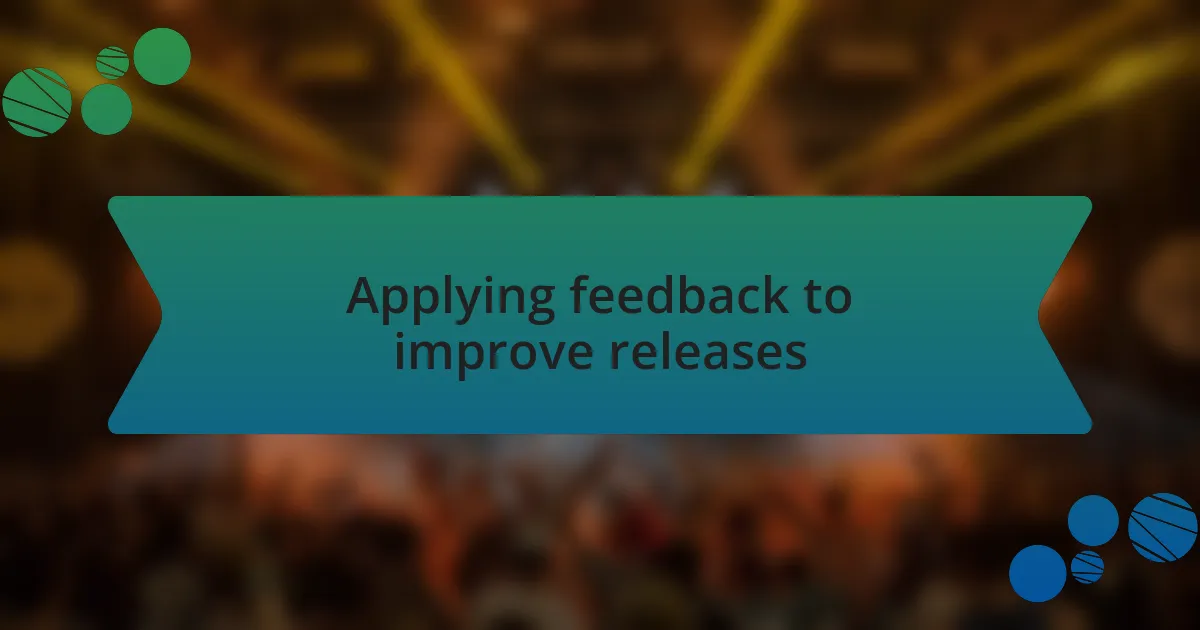
Applying feedback to improve releases
I often apply the feedback I receive to refine the vibe of a release. After my last EP, I was struck by a listener’s comment about how one track felt disjointed. It made me realize that not all transitions had the smooth flow I had envisioned. Isn’t it fascinating how one outsider’s perspective prompted me to re-evaluate the entire emotional arc of the project?
Engaging with feedback isn’t just about technical adjustments; it’s about connecting with the audience. During a release party, I noticed fans reacting differently to various tracks. One listener exclaimed how a specific bass line resonated with their personal experiences. This immediate response led me to explore more of those sound elements in future tracks. Have you ever identified a pattern in listeners’ reactions that influenced your creative choices?
Sometimes, the act of revisiting past feedback can yield unexpected insights. I keep notes from previous projects and often look back to see what resonated well and what didn’t. Recently, I stumbled upon a comment about the need for stronger melodic hooks. Reexamining that feedback inspired me to incorporate more melodic elements in my latest work, driving home the importance of memorable tunes. How do you keep track of the feedback you receive to ensure it informs your future projects?
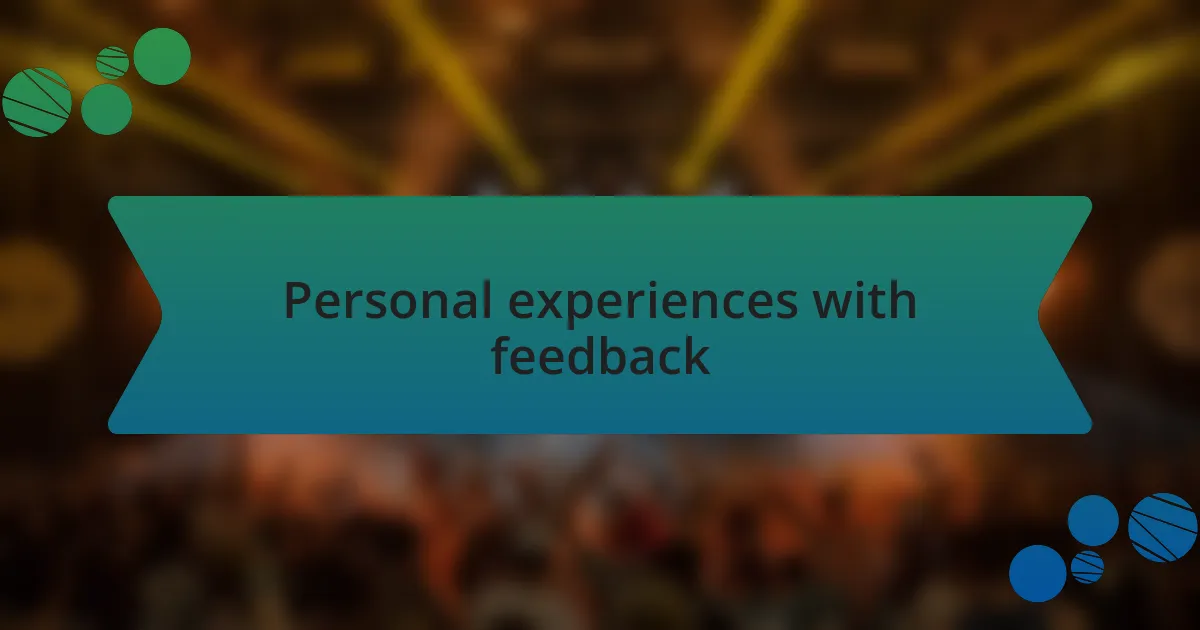
Personal experiences with feedback
Receiving feedback has been a transformative experience for me. I recall a time when a fellow artist critiqued my use of silence in a track. At first, I felt defensive, but their perspective opened my eyes to the potential of silence as a powerful tool for building tension and anticipation. Have you ever had someone challenge your creativity in a way that ultimately deepened your understanding?
One memorable instance was during a listening session, when a friend pointed out how a certain synth line didn’t quite match the mood we were aiming for. Their honesty was tough to swallow initially. However, after reflecting on it, I realized that sometimes a fresh pair of ears can identify dissonances that we, as creators, might overlook due to our familiarity with the work. How do you feel when someone challenges your artistic choices?
I’ve learned to embrace constructive criticism, especially during the mixing process. During one of my tracks, a collaborator suggested adjusting the vocal levels. Although I was attached to the original mix, I took their advice to heart. The subtle changes made the vocals shine, elevating the entire track; it was a reminder that collaboration can bring out the best in my music. Have you found that feedback from others can turn a good track into a great one?
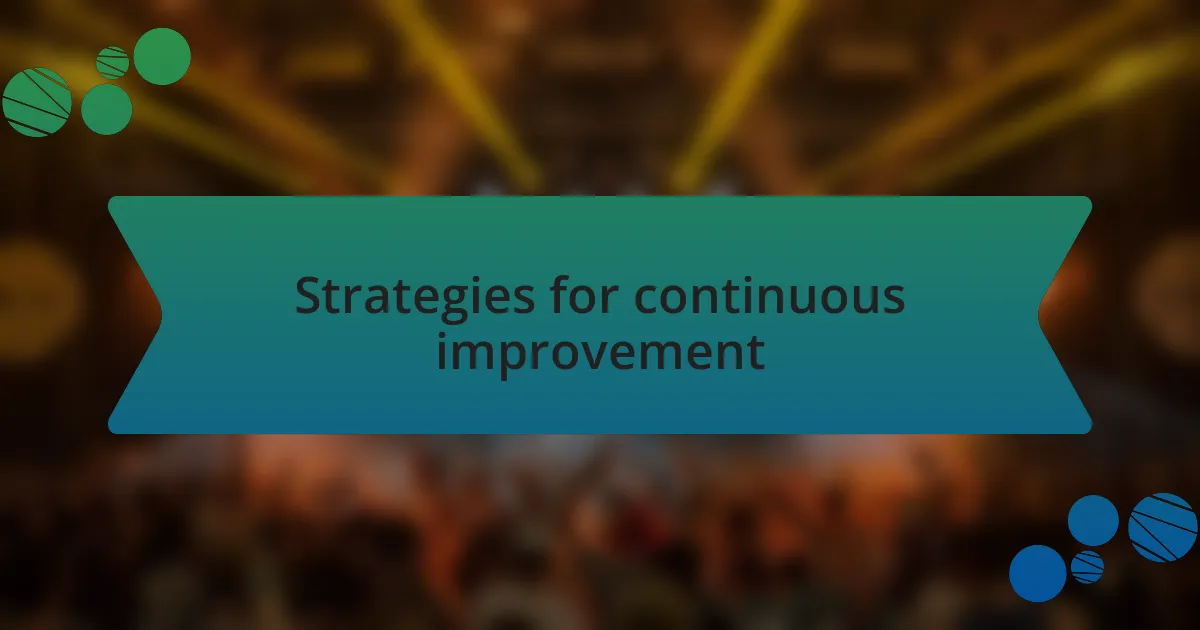
Strategies for continuous improvement
Embracing a culture of feedback has become a cornerstone of my creative journey. I remember a time when my team set up a monthly review session, where we’d share new tracks and receive honest critiques. Initially, it felt intimidating to bare my work, but over time, I found that discussing our projects collectively not only highlighted individual strengths but also fostered a supportive environment where all of us felt encouraged to innovate. Have you created spaces for open dialogue about your music?
One strategy I’ve adopted is implementing periodic surveys for listeners and collaborators. In one instance, I asked for feedback on our label’s promotional materials. The insights I received were eye-opening; they revealed preferences I hadn’t considered, helping us tailor our messaging and aesthetics more effectively. This practice is not just about gathering opinions; it’s about understanding our audience’s pulse and using that insight to evolve continually. How often do you seek the perspective of your audience?
Additionally, I’ve started tracking feedback trends over time. Noticing recurring themes, like preferences for certain genres or production techniques, has informed my future projects. For example, feedback highlighted a growing interest in live electronic performances, prompting me to incorporate more elements of live instrumentation in my tracks. This ongoing analysis creates a feedback loop that fuels my growth and aligns my music more closely with listener expectations. Do you keep an eye on how feedback patterns might shape your artistic direction?